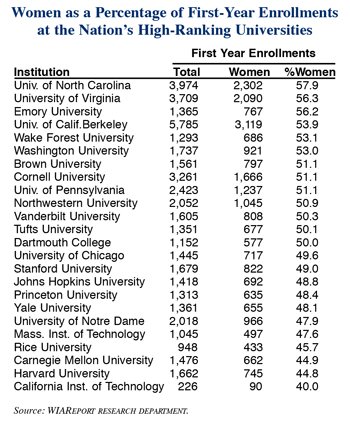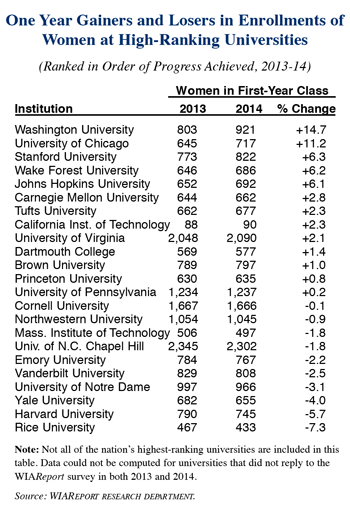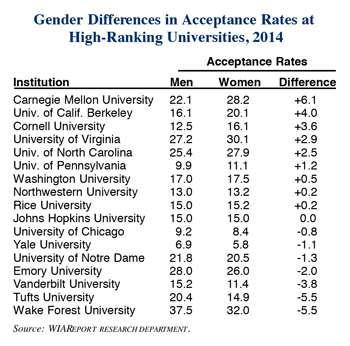First-Year Women at the Nation’s Leading Research Universities
Posted on Dec 30, 2014 | Comments 0
![]() For the fourth year in a row, WIAReport has surveyed the nation’s highest-ranking research universities to determine the percentage of women in this year’s entering classes. We also report on gender differences in acceptance rates at these schools and whether women have made gains in enrollments at these colleges compared to where they were a year ago.
For the fourth year in a row, WIAReport has surveyed the nation’s highest-ranking research universities to determine the percentage of women in this year’s entering classes. We also report on gender differences in acceptance rates at these schools and whether women have made gains in enrollments at these colleges compared to where they were a year ago.
Of the 24 high-ranking universities that responded to our survey, women were a majority of the entering students at 13 schools. A year ago, women were a majority of the first-year students at 17 of the 28 universities that responded to our survey
There are wide variations in the percentage of women in the first-year classes at these highly rated universities. For the fourth year in a row, the highest percentage of women in the entering class among this large group of leading research universities is found at the University of North Carolina at Chapel Hill. There are 2,302 women among the 3,974 entering students at UNC this fall. Thus, women make up nearly 58 percent of all first-year students.
The University of Virginia has the second-highest percentage of women in its entering class among this group of leading research universities. For the past two years, the University of Virginia was third in our survey. Emory University is third in this year’s survey with an entering class that is 57 percent female. Emory was second in last year’s survey. At the University of California at Berkeley, Washington University, and Wake Forest University, women make up more than 53 percent of the entering students.
At the other extreme, women make up only 40 percent of the entering students at the California Institute of Technology. But this is up nearly five percentage points from a year ago. Carnegie Mellon University in Pittsburgh and the Massachusetts Institute of Technology were also near the bottom. But this is hardly surprising considering that these schools have large numbers of students in engineering and other STEM disciplines where historically women have been vastly underrepresented.
Somewhat more surprising is the low percentage of women in the entering class at Harvard University this year. Women are just under 45 percent of the entering class.
We can compare last year’s results to the current data to see where women are making progress. Of the 23 leading universities for which we have data in both years, 13 schools show an increase in the number of women first-year students and 10 show a decline.
We find that the number of women in the entering class at Washington University in St. Louis is up 14.7 percent from a year ago, the largest increase in our survey. At the University of Chicago, the number of women in the entering class is up 11.2 percent from a year ago.
In contrast, the number of entering women students at Rice University in Houston is down more than 7 percent from a year ago. Harvard University, Yale University, and the University of Notre Dame had more than a 3 percentage point decline in first-year women students.
It is well known that nationwide women outpace men in college enrollments, graduation rates, and degrees earned. Because of a large and growing gender gap in enrollments at many colleges and universities, it has become easier for men to gain admission to some colleges and universities. It must be noted that just because men have a higher acceptance rate than women at a given institution does not necessarily mean that men have received an unfair admissions advantage. A particular college or university may simply have had an outstanding pool of male applicants in a given year.
We do note that many high-ranking universities are reluctant to report gender differences in acceptance rates. We will simply present the data and let readers make their own conclusions.
Of the 17 highly rated research universities that supplied data, we find that women were accepted at a higher rate than men at nine institutions. The greatest difference was at Carnegie Mellon University, which as stated is heavily focused on STEM disciplines. At this highly rated university, 28.2 percent of women were accepted for admission compared to only 22.1 percent of male applicants. Thus, there was a very large acceptance rate gap in favor of women of 6.1 percentage points. A year ago, there was a 11 percentage point advantage of women in acceptance rates at Carnegie Mellon.
The next highest acceptance rate gap in favor of women was 4 percentage points at the University of California, Berkeley. The only other leading research universities where the accepted rate for women was two percentage points higher than the rate for men were the Cornell University, the University of Virginia, and the University of North Carolina, Chapel Hill.
At the other end of the spectrum, Tufts University in Medford, Massachusetts, and Wake Forest University in Winston-Salem, North Carolina, had the highest gender gap in acceptance rates in favor of men. Tufts accepted 20.4 percent of male applicants but only 14.9 percent of women applicants. At Wake Forest, 37.5 percent of male applicants were accepted compared to 32 percent of women applicants. At Vanderbilt University in Nashville, men were accepted at a rate 3.8 percentage points higher than women.
Filed Under: Featured











